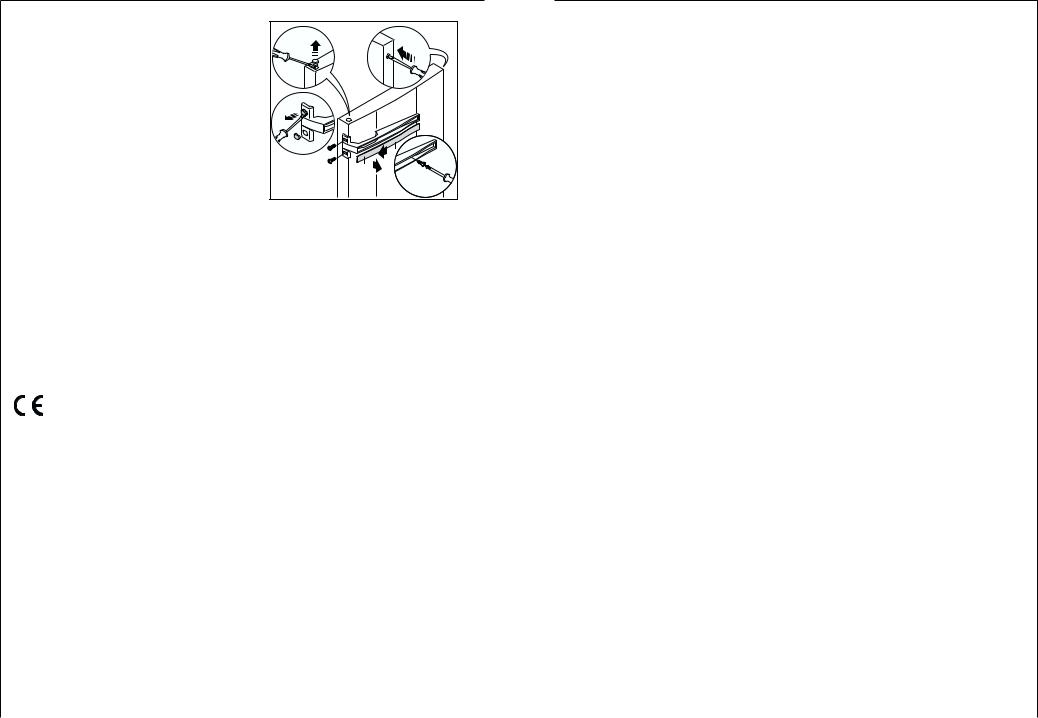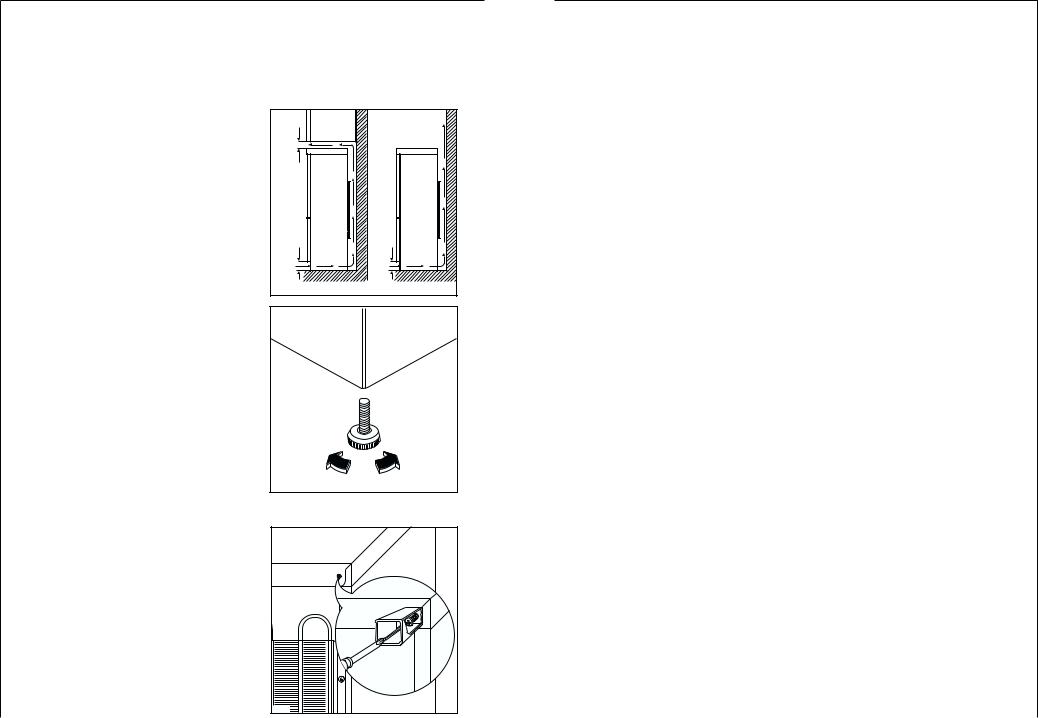AEG SANTO 70312-1 KG Manual [de]

SANTO 70312-1 KG
Fridge-freezer
Operating Instructions
AEG Hausgeräte GmbH
Postfach 1036
D-90327 Nürnberg
http://www.aeg.hausgeraete.de
© Copyright by AEG
2223 338-01 03/05 Subject to change without notice

Dear customer,
Before placing your new refrigerator/freezer into operation please read these operating instructions carefully. They contain important information for safe use, for installation and for care of the appliance.
Please keep these operating instructions for future reference. Pass them on to possible new owners of the appliance.
Notes which are important for your safety or for the proper functioning of the appliance are stressed with a warning triangle and/or with signal words (Warning!, Caution!, Attention!). Please observe the following carefully.
Additional information regarding operation and practical applications of the appliance appear after this symbol.
Tips and notes concerning economical and environmentally sound use of the appliance are marked with the flower.
In the event of a malfunction, these operating instructions contain information on how to rectify faults yourself, see the “Something Not Working” section.
For futher assistance contact your local AEG service Force Centre, see the chapter “Service and Spare Parts.
Printed on paper manufactured with environmentally sound processes.
who thinks ecologically acts accordingly ...
2

12.Dismantle the handles, by sliding the handle-cover, by unscrewing
its side and middle screws and reassemble them on the opposite side. Cover the holes left open with the plugs contained in the documentation pack.
1 
 2
2
Regulations, Standards, Guidelines
This appliance was designed for household use and was manufactured in accordance with the appropriate standards. The necessary measures in accordance with appliance safety legislation regulations (GSG), accident prevention regulations for refrigeration appliances (VBG 20) and the regulations of the German Society of Electrical Engineers (VDE) were observed in the manufacture of this appliance.
The refrigerant circuit has been checked for leaks.
This appliance is in accordance with the following EU guidelines:
– 73/23/EWG dated 19 February 1973 - low voltage guidelines.
– 89/336/EWG dated 3 May 1989
(including guideline change notice 92/31/EWG) - EMV guideline
Contents |
|
Safety . . . . . . . . . . . . . . . . . . . . . . . . . . . . . . . . . . . . . . . . . . . . . . . . |
. .4 |
Disposal . . . . . . . . . . . . . . . . . . . . . . . . . . . . . . . . . . . . . . . . . . . . . . |
. .5 |
Appliance Packaging Information . . . . . . . . . . . . . . . . . . . . . . . . . . . . |
. .5 |
Disposal of old Appliances . . . . . . . . . . . . . . . . . . . . . . . . . . . . . . . . . . . . |
.5 |
Remove Transport Packaging . . . . . . . . . . . . . . . . . . . . . . . . . . . . . . |
.5 |
Operation and control panel Fridge . . . . . . . . . . . . . . . . . . . . . . . . . |
.7 |
Starting up - Setting the Temperature . . . . . . . . . . . . . . . . . . . . . . |
.8 |
Interior Accessories . . . . . . . . . . . . . . . . . . . . . . . . . . . . . . . . . . . . . . |
.9 |
Storage shelves . . . . . . . . . . . . . . . . . . . . . . . . . . . . . . . . . . . . . . . . . . . . . |
.9 |
Door rack . . . . . . . . . . . . . . . . . . . . . . . . . . . . . . . . . . . . . . . . . . . . . . . . . . |
.9 |
Humidity control . . . . . . . . . . . . . . . . . . . . . . . . . . . . . . . . . . . . . . . . . . . . |
.9 |
Drawer . . . . . . . . . . . . . . . . . . . . . . . . . . . . . . . . . . . . . . . . . . . . . . . . . . . . |
10 |
Fresh food refrigeration . . . . . . . . . . . . . . . . . . . . . . . . . . . . . . . . . . |
10 |
Operating and indicator panel Freezer . . . . . . . . . . . . . . . . . . . . . . . |
11 |
Starting up - Setting the Temperature . . . . . . . . . . . . . . . . . . . . . . |
12 |
Freezing and storing frozen food . . . . . . . . . . . . . . . . . . . . . . . . . . . |
14 |
Preparation of Ice Cubes . . . . . . . . . . . . . . . . . . . . . . . . . . . . . . . . . |
15 |
Freezing calender . . . . . . . . . . . . . . . . . . . . . . . . . . . . . . . . . . . . . . . . |
15 |
Defrosting . . . . . . . . . . . . . . . . . . . . . . . . . . . . . . . . . . . . . . . . . . . . . |
16 |
Cleaning and Care . . . . . . . . . . . . . . . . . . . . . . . . . . . . . . . . . . . . . . . |
17 |
Energy Saving Tips . . . . . . . . . . . . . . . . . . . . . . . . . . . . . . . . . . . . . . . |
18 |
What to do if . . . . . . . . . . . . . . . . . . . . . . . . . . . . . . . . . . . . . . . . . . |
19 |
Correcting Malfunctions . . . . . . . . . . . . . . . . . . . . . . . . . . . . . . . . . . . . . |
19 |
Changing the light bulb . . . . . . . . . . . . . . . . . . . . . . . . . . . . . . . . . . . . . . |
20 |
Service and Spare Parts . . . . . . . . . . . . . . . . . . . . . . . . . . . . . . . . . . .21
Customer Care Department . . . . . . . . . . . . . . . . . . . . . . . . . . . . . . .21
Guarantee Conditions . . . . . . . . . . . . . . . . . . . . . . . . . . . . . . . . . . . .22
Installation - Electrical Connection . . . . . . . . . . . . . . . . . . . . . . . . .23
Positioning - Rear spacer . . . . . . . . . . . . . . . . . . . . . . . . . . . . . . . . . . . . .24 Reversing the door . . . . . . . . . . . . . . . . . . . . . . . . . . . . . . . . . . . . . . . . . .25
Regulations, Standards, Guidelines . . . . . . . . . . . . . . . . . . . . . . . . .26
26 |
3 |

 Safety
Safety
The safety aspects of our refrigerators/freezers comply with accepted technical standards and the German Appliance Safety Law. Nevertheless, we consider it our obligation to make you aware of the following safety information:
Intended use
•The refrigerator is intended for use in the home. It is suitable for the cooling, freezing and storing of frozen food, as well as for making ice. If the appliance is used for purposes other than those intended or used incorrectly, no liability can be accepted by the manufacturer for any damage that may be caused.
•Alterations or changes to the freezer are not permitted for reasons of safety.
•If you use the refrigerator in a commercial application or for purposes other than the cooling, freezing or frozen storage of foods, please observe all valid legal regulations for your application.
Prior to initial start–up
• Check the refrigerator for transport damage. Under no circumstance should a damaged appliance be plugged in! In the event of damage, please contact your retailer.
Refrigerant
The refrigerant isobutane (R600a) is contained within the refrigerant circuit of the appliance, a natural gas with a high level of environmental compatibility, which is nevertheless flammable.
•During transportation and installation of the appliance, be certain that none of the components of the refrigerant circuit become damaged.
•If the refrigerant circuit should become damaged:
–avoid open flames and sources of ignition;
–thoroughly ventilate the room in which the appliance is situated.
Safety of children
•Packaging (e.g. wraps, polystyrene) can be dangerous for children. There is a risk of suffocation! Keep packaging material away from children!
•Please make old appliances unusable prior to disposal. Pull out the mains plug, cut off the mains cable, break or remove spring or boltcatches, if fitted. By doing this you ensure that children cannot lock themselves in the fridge when playing (there is risk of suffocation!)or get themselves into other dangerous situations.
•Often children cannot recognise the hazards present in household appliances. It is therefore important that you ensure adequate supervision and never let children play with the appliance!
Reversing the door
The side at which the door hangs can be changed from the right side (factory supplied) to the left side, if the installation site requires.
Warning! When changing the side at which the door opens, the appliance may not be connected to the mains. Remove plug from the mains beforehand.
Procced as follow:
1.Remove the clip-in ventilation grille
2.Remove the bottom hinge (E) by unscrewing the fixing screws.
3.Slide the bottom door off the centre hinge (H).
4.Remove the centre hinge and slide the top door off pin (G); unscrew pin
(G)and refit it on the opposite side.
5.Remove the two plugs, to reveal the holes for the hinge pivots, and remount them on the other side.
6.Refit the top door and the centre hinge (H) on the opposite side.
7.Refit the bottom door.
8.Using a 10 mm spanner, unscrew the hinge pin (E) and reassemble it on the opposite side of the hinge;
9.Refit bottom hinge (E) on the opposite side, using the screws previously removed.
10.Remove blanking cover (F) from ventilation grille (D) by pushing it in the direction of the arrow and refit it on the opposite side.
11.Refit ventilation grille (D), clipping it into place.
|
E |
E |
F |
|
|
|
F |
|
|
|
|
|
|
F |
|
|
D |
|
F |
|
PR18 |
|
|
H |
G |
4 |
25 |

Positioning
This appliance should only be installed at a location where the ambient temperature corresponds to the climate classification indicated on the rating plate, which is located at the left on the inside of the appliance.
The following table shows which ambient temperature is correct for each climate classification:
SN +10°C to + 32°C
N+16°C to + 32°C
ST +18°C to + 38°C
T+18°C to + 43°C
For correct operation this appliance must be located in a dry atmosphere, away from heat sources, e.g. cookers, radiators, boilers and direct sunlight.
You should also ensure that air can circulate freely around the back and the top of the cabinet. There should be 100mm (4”) between the top of the cabinet and any overhanging kitchenfurniture. Alternatively allow 50mm (2”) between the top of the cabinet and any overhanging kitchen furniture and a gap of 25mm (1”) on either side of the appliance.
Do not obstruct the space underneath. The back of the cabinet may be placed close to the wall but must not touch it. DO NOT install in places with restricted ventilation.
Adjust the level of the appliance by screwing out the adjustable foot, or feet, at the bottom of the cabinet using your fingers.
Rear spacers
Fit the rear spacers contained in the documentation bag to ensure escape of heat generated during operation. Proceed in the sequence illustrated in figures.
100 mm |
|
10 mm |
10 mm |
NP00 |
|
D200 |
|
D594 |
Daily Operation
•Containers with flammable gases or liquids can leak at low temperatures. There is a risk of an explosion! Do not store any containers with flammable materials such as, for example, spray cans, fire extinguisher refill cartridges etc in the refrigerator/freezer.
•Bottles and cans must not be placed in the freezer compartment. They can burst when the contents freeze, high carbonate content drinks can even explode! Never store lemonade, juices, beer, wine, sparkling wine etc. in the freezer compartment. Exception: high alcohol content spirits can be stored in the freezer compartment.
•Do not put ice creams or ice cubes in the mouth immediately after removal from the freezer compartment. Very cold ice can freeze to the lips or tongue and cause injury.
•Do not touch frozen food with wet hands. Your hands could freeze to the food.
•Do not operate any electrical appliances in the refrigerator/freezer (e.g. electric ice cream makers, mixers etc.).
•Before cleaning the appliance, always switch off the appliance and unplug it, or pull the house fuse or switch off the circuit breaker.
•When unplugging always pull the plug from the mains socket, do not pull on the cable.
Service
•Under no circumstances should you attempt to repair the appliance yourself. Repairs carried out by inexperienced persons may cause injury or serious malfunctioning. Contact your local AEG Service Force Centre.
Disposal
Appliance Packaging Information
All materials are environmentally sound!
The plastics can be recycled and are identified as follows:
>PE< for polyethylene, e.g. the outer covering and the bags in the interior.
>PS< for polystyrene foam, e.g. the pads, which are all free of chlorofluorocarbon.
The carton parts are made from recycled paper and should be disposed of at a waste-paper recycling collection location.
Disposal of old Appliances
For environmental reasons, refrigeration appliances must be disposed of properly. This applies to your old appliance, and - at the end of its service life - for your new appliance as well.
24 |
5 |
